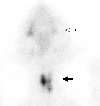Hyperthyroidism and neutering; is there a link?
Hyperthyroidism (an overactive thyroid gland) is now a very common in geriatric cats, affecting almost 10% of cats over 9 years, but this disease was not commonly recognised until the 1980s. The reasons for the emergence of hyperthyroidism are unclear, certainly improved recognition and diagnosis of the condition and an increase in lifespan of our feline companions is a partial explanation, but a true increase in disease prevalence also seems likely.
This grant, awarded by the PetPlan Charitable Trust, will support a PhD student, Joana Aguiar (who is already a qualified vet and specialist in internal medicine), to investigate the novel hypothesis that hyperthyroidism develops in cats as a response to neutering. This practice increased throughout the 1960s and became commonplace by the 1970s and the clinical manifestations of hyperthyroidism were first described one to two decades later. Hyperthyroidism is a disease of old-age so it would be expected that there would be a lag of at least 8-10 years for neutered kittens to become old enough to develop the disease with any frequency. In addition, histological (microscopic examination of thyroid glands) studies indicate that hyperthyroidism was present within the feline population for some time before it was recognised clinically.
In response to neutering production of the gonadotrophic (literally gonad-stimulating) hormones; LH and FSH, increases in an attempt to stimulate the (absent) ovaries/testis. These hormones are closely related to thyroid stimulating hormone (TSH), which stimulates the thyroid gland to produce hormone by binding to its receptor (TSH-R). It is known that gonadotrophic hormones can bind to the TSH-receptor and by doing so may alter the function of the thyroid gland. For example, pregnant women may develop hyperthyroidism due to the secretion of (LH-like) hormones by the placenta.

The link between hyperthyroidism in cats will be investigated in several different ways. A colony of cats where some are neutered and others are not will be studied to see if concentrations of thyroid hormone (T4) and TSH are altered in young adult cats, and if these are related to LH and FSH concentrations, prior to any changes that might be associated with hyperthyroidism. Historical records from the colony will also be examined to determine if there is a difference in the rate at which hyperthyroidism develops in neutered and unneutered cats. Additionally, when owners consent to it, thyroid cells will be cultured from cats that are being euthanised in the RVC’s hospitals due to unrelated diseases. These thyroid cells can then be tested in the laboratory to see how they respond to the addition of LH and FSH hormones. Finally, so-called ‘transcriptomic analysis’ (using RNA-sequencing) of these thyroid glands will be used to determine which genes are being turned on and off so the steps involved in triggering the development of hyperthyroidism can be more completely understood.

You may also be interested in:
-
New research from the RVC predicts the future life expectancy for companion cats
New research from the Royal Veterinary College (RVC), in collaboration with researchers from the …

